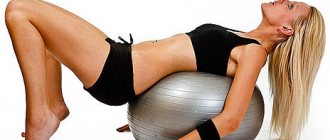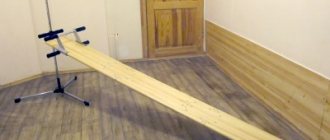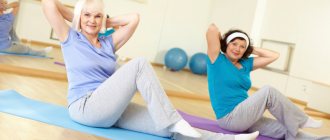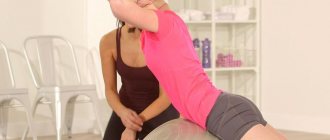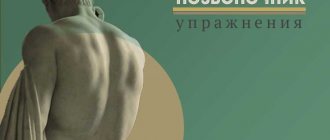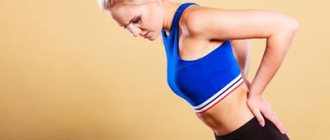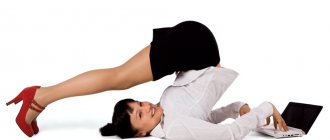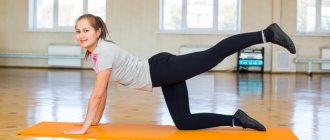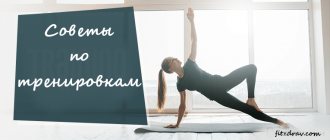According to statistics, approximately 80% of people after 25 years of age suffer from problems with the spine. This is due to the fact that most of them lead a passive lifestyle or, conversely, do hard physical work every day. Then degenerative-dystrophic changes in the spine develop, which is accompanied by pain and limited mobility.
Pilates for the back will strengthen the spine and surrounding muscles, relieve pain, and correct posture. This system of exercises will help delicately and carefully restore the spinal column after injuries. There are many complexes for different parts of the spine. But for the exercises to be beneficial, you need to learn the rules for doing them. In addition, you should know that there are contraindications to Pilates exercises.
What is Pilates
Some people don't yet know what Pilates is. Pilates gymnastics for the spine is a system of exercises authored by John Pilates. It was created for the rehabilitation of the spine after severe injuries. This technique has existed for more than 100 years, during which time it has not lost its popularity. This is due to the high efficiency and safety of this system.
This system of exercises involves performing gentle exercises aimed at gentle stretching and gradually strengthening the muscles. In Pilates complexes there are no sharp rhythmic movements that can cause injury. When performed correctly, exercises can increase the flexibility of the body without increasing muscle mass. Training can be carried out by people of any age and gender at home.
Reference. To achieve good results, Pilates classes should be done regularly (at least 2-3 times a week for 20-25 minutes). Only in this case will you be able to achieve a healthy spine, as well as a slender, flexible body.
Gymnastics can be performed on the floor without or with additional equipment, as well as on special machines. The lesson begins with a warm-up, which will warm up the muscles and ligaments, increase their elasticity, and prepare for further work.
According to reviews, if you follow the rules, Pilates allows you to achieve the following positive effects:
- Development of muscles that are not used during normal activities.
- Activation of blood circulation and metabolic processes in the body.
- Strong muscles around the spine will help reduce stress on damaged intervertebral discs.
- Improved posture, uniform load on the spinal column, prevention of many diseases.
- Normalization of weight, which also allows you to unload the spine.
- Relaxation of tense muscles.
Exercises can be performed even with herniated discs. With regular exercise, the load on the damaged cartilage pad is reduced and its recovery is accelerated.
Reference. Pilates for a herniated disc is prohibited only during exacerbation of the disease. The advantage of this system is that there is no force or vertical load, since classes are often conducted in a horizontal position.
A set of Pilates exercises for spinal hernia
Before starting the complex, you must perform warm-up exercises consisting of 6 exercises described at the beginning of the article.
- Feet shoulder width apart. Take a deep breath and exhale. Breathing is full and even.
- To warm up, try to make a full circle in one direction, then in the other direction.
- Press your chin to your chest. Then tilt your head back. Slowly turn your head, first one way, then the other.
- Work the joints of your hands by placing them on your shoulders. Starting to rotate your shoulders back and forth.
- Feet on toes. Then back to the heel.
All classes according to this system are recommended as therapeutic exercises. It should not be done for those people whose disease has worsened. The good thing about the system is that there is no power or vertical load. Since many exercises are recommended to be performed lying down. In this position, the load will be distributed evenly.
The very first lessons must begin under the guidance of a competent specialist. All exercises will have a relaxing and gentle effect on intervertebral hernias. The muscle corset will noticeably strengthen.
Training principles
Pilates gymnastics is based on the following principles:
Morning exercises for the back and spine
- Concentration. A person should focus on the muscle groups being worked. The more the patient feels how the muscles work, the better the result will be.
- Relaxation. It is not recommended to train in a bad mood. It is important to get rid of anxious thoughts and calm down.
- Alignment. Each joint must take its place during exercise, because even with the slightest displacement there is a risk of injury.
- Coordination. At first, you need to master the technique of performing the exercise. Then it will happen automatically.
- Centering. When doing back exercises, you need to stabilize your abdominal muscles, including your transverse abdominis.
- Correct breathing technique. During training, you need to breathe deeply and calmly so that the air passes and is retained in the lower parts of the lungs. This will saturate the blood with oxygen, increase endurance and physical capabilities.
If these principles are followed, Pilates will benefit the entire body.
Rules and tips for performing a set of exercises
The exercises developed by Joseph Pilates are carried out in three directions. Can choose:
- option of working on the floor;
- exercises with special objects;
- training on simulators.
It is important to do movements smoothly during classes without unnecessary pauses and rests. Gentle exercises vary, allowing the muscles to warm up as much as possible. Muscle structures normalize their functionality; after stretching, they are characterized by firmness and elasticity.
Experienced specialists share secrets, following which even a beginner will feel positive changes in the body in just a few workouts:
- When training, it is better to wear light, non-restrictive knitted clothing.
- You should exercise barefoot. Contact of the feet with the floor surface increases the functioning of blood flow and activates the points responsible for the full functioning of internal systems and organs.
- When performing a set of exercises, it is important to monitor the position of your head. It must be held exactly at the level of the body.
- Before classes, it is important to undergo breathing exercises. By tensing the abdominal and pelvic floor muscles, the lungs should be filled with a stream of fresh air.
- The main task when performing movements is to stretch the spine as much as possible to increase the distance between the vertebral discs.
The exercises are characterized by gentle stretching followed by strengthening of muscle structures. You cannot train with heavy physical exertion.
The main components of Pilates are:
- Relaxation. Before training, it is important to eliminate the negative emotions accumulated during the day and get rid of bad thoughts. You must be in a state of complete moral satisfaction.
- Concentration. The principle is to focus on a selected muscle group. The better a person is concentrated, the more effectively the movement is performed with a positive outcome after training.
- Alignment. The main requirement in training. Each joint should be located in its designated place so as not to cause injury.
- Breath. Preparatory stage before classes. You need to breathe correctly, holding the air in the lower part of your lungs. Precise breathing eliminates shortness of breath.
- Centering. Refers to basic principles. It is justified by the opinion that it is possible to perform movements accurately when the transverse muscle structure is stabilized. It has been proven that the abs are responsible for supporting the spine.
- Coordination. The principle allows you to bring exercises to exceptional precision. Coordination is possible after several classes in which a person has maximum control over the correct execution of movements.
The advantage of the technique is that during movements a person is protected from unwanted stretching of muscles, tendons, and dislocations of the upper or lower extremities. You should not continue to do exercises that cause pain or discomfort.
Who is Pilates suitable for?
“Gymnastics for the lazy,” as Pilates is also called, is suitable for the following groups of patients:
- People who have experienced injuries to the musculoskeletal system (sprained ligaments, muscles, broken bones, etc.).
- Patients who have been diagnosed with osteochondrosis. You can exercise even if you have a herniated disc, the main thing is to consult with your doctor before training.
- Pregnant women, as well as women after childbirth, can also perform “gymnastics for the lazy.”
- People with varicose veins.
- Overweight patients with joint pain.
- Elderly people with limited mobility.
- Persons who lead a passive lifestyle or perform heavy physical work every day. Gymnastics will help increase muscle tone, stretch them, and relax them.
- Pilates is ideal for beginners who have not previously exercised. After mastering this system, you can move on to more complex sports.
Pilates for the back is suitable for people who have not previously exercised
With Pilates you can get rid of back pain without putting excessive stress on your spine. This gymnastics is safe for health, and the risk of injury during its implementation is minimal.
This exercise program helps increase the strength of the abdominal and back muscles. All exercises are performed smoothly, so the muscles and ligaments are not overstrained, pain in the back disappears, and the likelihood of spinal pathologies is reduced.
Reference. To achieve a therapeutic effect during Pilates, you need to learn how to correctly distribute the load on the back muscles. This will relieve the vertebrae and also eliminate pain.
With regular exercises, even the deepest back muscles are strengthened, which then support the vertebrae, preventing the formation of protrusions and hernias. Relaxation exercises help relieve muscle spasms, improve blood circulation, metabolic processes, and trophism of the tissues of the spinal column.
Is Pilates safe for back problems?
Many experts recommend practicing this unique technique for many diseases, as it is safe and has a therapeutic effect. Back exercises using the unique Pilates technique allow you to:
- Lose weight and thereby reduce the load on the pinched vertebra or the musculoskeletal system as a whole.
- Eliminate stress on the spine while performing tasks, since most actions are performed in a sitting position or lying down.
- All techniques allow you to work on the muscular framework, which is the basis of spinal health.
- Correct posture gradually appears, the shape looks fit, the silhouette is beautiful. This is an excellent prevention of the development of scoliosis and is beneficial for the lower back.
- Muscle spasm, which often accompanies a sedentary lifestyle, is relieved.
- Blood flow in muscles and connective tissues improves, and the functioning of intervertebral discs is normalized.
But an important condition is the correct, most accurate execution of the exercises. The technique is recommended for almost everyone, but in some cases the complex can be adjusted, and some exercises can be cancelled.
Contraindications
Before practicing this system, you need to study possible contraindications, because in some cases Pilates can harm your health.
It is prohibited to perform “gymnastics for the lazy” in the following cases:
- Serious diseases in which a person’s condition significantly worsens.
- Infectious diseases accompanied by fever.
- The likelihood of bleeding in the postoperative or post-traumatic period.
- Injuries after which a foreign body enters the body.
- Severe pain of unknown origin.
- Cellulitis or abscesses.
It is strongly recommended that you consult with a physician or professional instructor before exercising, especially if you have a chronic illness.
Important. Before training at home, do several classes under the supervision of a trainer to master the basics of Pilates. The specialist will tell you what mistakes you are making and also explain how to correct them.
Exercises with equipment
Such complexes are sometimes called methods for perfect posture. In some cases, they are supplemented with elements for the development of the chest or arm muscles and other parts of the body. To perform the exercises, you need to use additional equipment:
- Dumbbells. You need to stand straight, take light dumbbells in your hands. The limbs are raised at right angles at the same time or one at a time, then the training is complicated by slight bends forward.
- Elastic tape. Lying on your side, the tape is secured to your thigh so that your foot rests on it. The limb is extended one by one, overcoming the resistance of the tape.
- Ball. You need to lie on a special ball and make moderate movements to the sides. Training on the ball can also be done in a sitting position, raising your arms up and performing actions that resemble stretching.
Useful tips
Before you start training, you need to study the following recommendations:
- Do Pilates in clothes that do not restrict your movement. It is better to train barefoot so as not to disrupt the blood circulation in your legs.
- To master the Pilates technique, take several classes under the guidance of an instructor.
- Before training, consult your doctor, he will tell you how often you can exercise.
- Warm up before gymnastics.
- During home workouts, monitor your technique, concentrate on a specific muscle group, and control your breathing.
- Perform the exercises slowly and smoothly.
- When doing gymnastics, try to keep your back straight; after 10 to 15 sessions, your posture will improve.
- The first workouts should consist of simple exercises without additional equipment. Over time, you can try more complex exercises. Increase the amplitude gradually to avoid injury.
- Perform the complex at a smooth pace without interruption (except in cases where this is specifically stated).
- Perform the exercises in the order that the instructor created for you.
- To help your spine stretch better, pull in your stomach and hold it in that position.
It is better to train in comfortable sportswear and barefoot
Remember that Pilates is a rehabilitation system that does not involve impact loads. This gymnastics consists of stretching exercises, not strength exercises.
Selecting the best exercises
The doctor will help you select a set of effective exercises after identifying the cause of the development of the pathological process. It is important to correctly explain to the specialist in which part of the spinal column the discomfort is felt. It is important to describe the intensity of pain attacks, duration and systematicity.
In turn, the doctor studies the medical history, chronic pathologies, individual organs and systems. The doctor takes into account the patient’s age and level of physical fitness so that the exercises are given without difficulty and without putting a lot of stress on the affected area.
Neck exercises
The cervical region is responsible for the full functioning of the brain and vascular systems of the head. When diagnosing cervical osteochondrosis, doctors prescribe therapeutic manipulations to cleanse the blood channels. Pilates for osteochondrosis helps restore fragments damaged by the inflammatory process.
Neck exercises should be performed carefully, avoiding sudden movements. The following actions are carried out comprehensively:
- Sit in the lotus position, calm down, concentrate and tilt your head 4 times forward and backward, left and right. Breathing should be uniform and calm.
- The next stage is conditional drawing of a semicircle with the chin. Move your chin from left to right. The head tilts towards the chest when turning. When performing, be sure to follow the techniques: slowness, accuracy, concentration.
- Next, you need to put your forehead in your palms, resisting the pressure of your palms with your head. We actively press while inhaling, inhaling and resting. The exercise is performed three to five times. In the same way, you need to apply resistance to the side - to the left, then to the right.
You can perform the exercises in a standing position. Hands are on the shoulders. The neck is stretched upward as much as possible, the hands put maximum pressure on the shoulders. Inhalation should not last longer than 20 seconds. Next, exhale, after which the muscle structures should relax.
When performing the proposed exercises, you must not forget about concentration and proper breathing. It is recommended to use all groups of muscle structures. You can close your eyes and imagine how your navel is attached to your lower back, holding your abdominal muscles. It is important to train daily, increasing the load. Systematicity is the key to efficiency.
Exercises for the thoracic region
Painful attacks in the thoracic vertebra signal the development of a pathological process. To relieve symptoms in the first stages of manifestation, it is recommended to perform complex gymnastics:
- The exercise is performed while sitting on a chair with a straight back. You need to sit upright, placing your clasped hands on the back of your head. Next, you need to bend so that your back is in contact with the back of the chair.
- Sitting on the edge of a chair, your back should touch the back. After the correct starting position, backbends and forward bends are performed. Deflection - inhale, tilt - exhale. This exercise normalizes the functionality of the vertebra and improves the performance of the lungs.
- The handy item for the following exercises is a towel. First, wrap it around the rolling pin, making a roller of medium hardness. You need to lie on your back on the equipment you made yourself, located on a flat surface (the roller should be in the chest area). We raise our arms up above our heads. After 5-10 seconds, move the upper limbs behind the head. As you inhale, bend backwards, and as you exhale, bend forward. After 10-15 bends and bends, it is advisable, while in this position, to roll the roller along the spine, which helps develop the vertebrae and the entire area of the sternum.
- Using a towel you can perform another useful exercise. To carry it out, the chest section of the body is wrapped. The ends of the towel should remain in your hands. First, inhale as deeply as possible, and as you exhale, pull the towel tightly. Afterwards, the tension should be loosened and the air flow should be inhaled again.
Pilates is approved by doctors for grade I-II scoliosis. If exercises are done at home, you can use a fitball. Sitting on the ball, we spread our legs and place our arms along the body. Inhaling, we raise our upper limbs up, stretching the back muscles as much as possible. Exhaling, we return to the starting position.
To relieve the tension in the vertebra that has formed during the day, it is recommended to lie on the exercise ball with your stomach. Relax your arms and legs as much as possible and leave them in a freely hanging position. The exercise consists of rolling the body forward and backward.
With the development of osteochondrosis of the thoracic region, exercises should be selected by a doctor. It is important to repeat the execution at least 7-15 times. If you feel discomfort, you should not hide the unpleasant sensations from the doctor, who has several more options in stock.
Complex for back and spine
As mentioned, you should start training with a warm-up:
- Stand with your feet at shoulder level, take a deep breath, stretch your arms up, then exhale and lower yourself.
- Gently press your chin to your chest, then raise your head, lower it back, and then to the sides. Slowly rotate your head in a circle to the right and then to the left.
- Rotate your hands, then your elbows, and then your shoulders back and forth.
- Place your hands on your belt, tilt your body back and forth, and then left and right. Then rotate your torso, gradually increasing the amplitude.
- Make smooth swings of your legs back and forth, and then to the sides.
- Roll from your toes to your heels and back.
These exercises will help warm up the muscles and make the ligaments more elastic. After warming up, the likelihood of injury decreases, so it is necessary to do it.
The treatment complex consists of 7 exercises, during which you can strengthen and increase flexibility not only of the back, but also of other muscles of the body.
Effective exercises for the back and spine:
- Lie on your back, place your arms along your body, straighten your legs, pull in your stomach. Inhale, simultaneously pull your toes towards you and lift your torso to be in a sitting position. Raise your body by tensing your abdominal muscles, try to feel your spine.
- From a sitting position, lean forward towards your feet, try to stretch as much as possible, but so as not to cause pain. Stay at the bottom for 5 – 10 seconds. Then smoothly lift your body, lowering yourself to a horizontal position.
- During the return movement, concentrate on the spine. When you lie on your back, pull your stomach in.
- In a lying position, bend your knees and rest on your feet.
- Begin to lift your pelvis up, leaning on your shoulders, arms and feet. Raise your spine, starting from the lower (sacrum) to the thoracic region. Hold for a few seconds, tensing the muscles of your abdomen, back, and buttocks. Then lower yourself.
- While lying down, straighten your legs and tighten your abdominal muscles. Then pull your toes towards you without lifting your heels from the floor. At the same time, raise your head, trying to touch your chin to your chest. Hold for 2 - 3 seconds, and then lie down again.
- Roll over onto your stomach, place your hands under your chin. As you exhale, raise your head, arms, and upper body, hold for 3 seconds, then lie down again. Do not rise excessively to avoid pain.
The number of repetitions and approaches is determined by the instructor.
Pilates improves posture and makes the spine more flexible
There is another simple but effective complex that will help strengthen the muscles around the spinal column:
- Sit down, straighten your legs, spread them so that they are at shoulder level, turn your feet to your lower limbs at a right angle, stretch your arms forward. Inhale and gently bend your back, rounding it, continue to stretch your arms, but do not touch your legs. Then exhale and smoothly straighten your back (first your lower back, then your chest and neck).
- Lie on your back, raise your head and shoulders. Then raise your legs by tensing your abdominal muscles in this way: bend one limb, bring it closer to your chest no more than 90°, and straighten the other and lift it above the floor at an angle of 45°.
- Roll over onto your stomach and extend your upper and lower limbs as if you were about to swim. Alternately lift your legs and arms off the surface, pretending that you are swimming. Perform 5 swings of the upper and lower limbs during one inhalation and the same number of movements when exhaling.
- You can complete the complex with the “pelvic bridge” exercise. This sports element develops the muscles that are responsible for flexion and extension of the back, as well as the muscles of the buttocks and thighs.
During gymnastics you need to focus on the muscles being worked.
A personal instructor can create an individual complex for each patient.
Lower back workout
Damage to the lumbar region is often associated with a lack of motor activity, then the muscles weaken, discomfort and pain appear. When the first unpleasant sensations occur, you should start exercising.
Complex for the lower back:
- Kneel down, lower your buttocks onto your heels, then bend your back, rounding it, and stretch your arms forward. Stretch your back along with your arms, then lift your body and repeat.
- Lie on your back, bend your elbows. Then raise your head, feeling the tension in your lower back muscles, hold for a few seconds, and lower yourself.
- Do not change your position, bend your knees, place your arms along your body. Raise your pelvis with emphasis on your hands and heels, bringing your knees forward. Lower your back as follows: first the thoracic region touches the floor, and then the sacrum. Tighten your abdominal and back muscles, but not your shoulders.
- Stay in the same position with your arms outstretched. Rest on your toes, lift your heels, bring your knees together. Turn your feet to the right, trying to touch the floor with them. Then lift them up and repeat to the left. While moving, do not lift your shoulders off the floor.
This is just one example of numerous complexes that are suitable for beginners. Consult your doctor before performing it.
Neck exercises
Many people who work at a computer suffer from cervical osteochondrosis. This complex was created just for them, which will help get rid of pain and restore mobility to the cervical segment of the spine:
- Stand with your palms on your shoulders. Smoothly stretch your neck as high as possible, holding your shoulders with your hands. Stretch your neck for 10 - 15 seconds, and then return to the starting position.
- Continue standing, lower your arms, keep your back straight. Smoothly pump your head left and right, and then back and forth. Move slowly, feeling the stretch in your neck muscles.
- Do not change your position, place your feet at shoulder level, lower your arms, straighten your back. Perform the previous exercise, but at a faster pace. At first, the amplitude of movements should be small, it should be increased gradually.
Neck exercises help relieve pain and restore neck mobility
During your workout, focus on your neck muscles.
A set of Pilates exercises for the lower back
The lower back is often injured, especially a hernia of the lumbar spine. Pilates for a hernia of the lumbar spine not only helps to cope with it completely, but also to alleviate the discomfort and pain of a person.
- On the floor, assume an animal pose. Place your buttocks on the heels of your feet, arms extended forward. Tighten your entire body, lengthening your spine. Take it slow.
- Lie down on the floor. The arms are bent at the elbow. Begin to raise your head, feeling the bend in your lower back.
- Lie on your back. Legs are bent. Raise your pelvis off the floor as high as possible. Feel the stretch in your lower back.
- Lying on your back with your knees bent. Start moving both legs from one side to the other. Notice the sensation in your lower back.
READ ALSO: How to make your buttocks beautiful: technique for proper squats at home
Main conclusions
Pilates for the back will help restore the spine after injuries, get rid of discomfort, pain, maintain physical fitness, and increase body flexibility. This gymnastics is suitable for people of any age and gender. However, it should be remembered that there are some contraindications to Pilates. To avoid unpleasant consequences, you should consult your doctor before training. All movements should be performed smoothly, at a slow pace, without jerking. During classes, you need to be in a relaxed psychological state, focus on the muscles being worked, and monitor your breathing. The first training should be carried out under the supervision of an instructor; only after mastering the technique can you practice at home. With regular exercise, you will be able to strengthen your back muscles, make your ligaments more elastic, and relieve pain. Pilates is recommended for the prevention of many spinal diseases.
Functions, tasks, features of the exercise system
Pilates is similar to yoga in its principles - the main thing is breathing and concentration on the muscles
Pilates for a healthy back is strengthening and accelerating the recovery process of the spine after injury. This technique also helps to get rid of pain and other unpleasant symptoms that accompany lesions of the column:
- quick relaxation – relieving stress, fatigue, muscle spasms;
- alignment – with the help of exercises you can improve the position of the vertebrae;
- concentration – during Pilates no active and dynamic actions are performed, but it is important to focus on proper breathing and muscle tension;
- coordination – Pilates helps improve control over one’s own movements;
- correct breathing - exercises require strict adherence to inhalation and exhalation, due to which respiratory activity is normalized;
- centering - important attention is paid to the transverse abdominal muscle.
Pilates is good for back health in general, but also has certain indications for back problems.
Indications and contraindications
Pilates is recommended for various back pathologies associated with the spine or muscles
Doing Pilates for back health is especially useful for the following diseases:
- chronic pain in the spine;
- pathologies of the lower back;
- osteochondrosis;
- curvature;
- intervertebral hernia.
You cannot perform exercises with progressive osteoporosis, arthrosis, scoliosis, acute injuries and spinal fractures. Acute colds, mental disorders, problems with coordination and hyperthermia are included in the list of contraindications.
